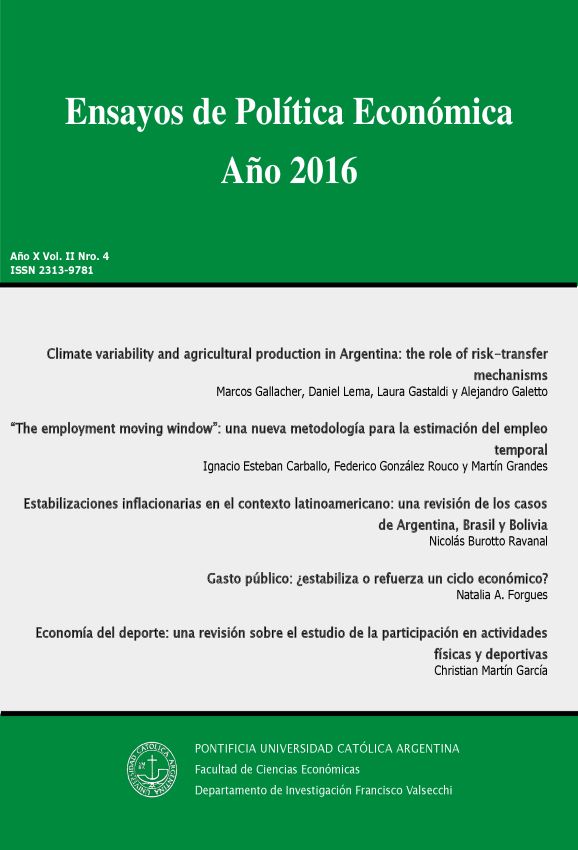Economía del deporte: una revisión sobre el Estudio de la participación en actividades físicas y deportivas
Palabras clave:
economía del deporte, teorías neoclásicas, actividades físicas y deportivasResumen
La participación en actividades físicas y deportivas ha sido estudiada por los economistas utilizando dos aproximaciones; una es la ortodoxa neoclásica, la cual aplica el modelo de compensación de ingresos por tiempo de ocio relacionándolo con la oferta de trabajo; y la otra, la heterodoxa de las ciencias sociales, la cual integra aspectos económicos, sociológicos y psicológicos. Dentro de las dos aproximaciones, el análisis de la participación deportiva ha sido indirecto e incluso refleja las diferentes preocupaciones teóricas generales acerca de cómo modelar la decisión de participar. En este trabajo, se realiza una revisión de literatura sobre las principales teorías neoclásicas que han sido utilizadas en el estudio de la demanda de actividades físicas y deportivas, y sobre trabajos empíricos derivados de su aplicación.Descargas
Citas
Alfonso, A., y Ramos, C. (2012). Determinantes de la actividad física en México. Estudios Sociales (Hermosillo, Son.), 21(41), pp. 185–209.
Andersson, P., Balia, S., Jones, A. M., Becchetti, L., Pelloni, A., Rossetti, F. (2011). The economic imagination: towards a behavioural analysis of choice. Kyklos, 21(1), pp. 1–15.
Becker, G. (1974). A theory of social interactions. Journal of political economy 82(6). Recuperado de http://www.nber.org/papers/w0042.pdf
Becker, G. S. (1965). A Theory of the Allocation of Time. The Economic Journal, pp. 493–517.
Bourdieu, P. (1984). Distinction: A social critique of the judgement of taste. Harvard University Press.
Bourdieu, P. (1988). Program for a Sociology of Sport. Sociology of Sport Journal, 5(2), pp. 153–161.
Bourdieu, P. (2011). The forms of capital. Cultural Theory: An Anthology, 81–93.
Breuer, C., y Wicker, P. (2008). Demographic and economic factors influencing inclusion in the German sport system – a microanalysis of the years 1985 to 2005. European Journal for Sport and Society, 5(1), 33–42.
Brown, H., y Roberts, J. (2011). Exercising choice: The economic determinants of physical activity behaviour of an employed population. Social Science and Medicine, 73(3), 383–390.
Cansino, K., y Gálvez, H. (2014). Determinantes de la participación en actividades físicas en el Perú. Revista Peruana de Medicina Experimental Y Salud Publica, 31(1), 11–12.
Cawley, J. (2004). An economic framework for understanding physical activity and eating behaviors. American Journal of Preventive Medicine, 27(3), 117–125.
Colman, G., y Dave, D. (2013). Exercise, physical activity, and exertion over the business cycle. Social Science & Medicine, 93, pp. 11–20.
Downward, P. (2007). Exploring the Economic Choice to Participate in Sport: Results from the 2002 General Household Survey. International Review of Applied Economics, 21(5), pp. 633–653.
Downward, P., Dawson, A., y Dejonghe, T. (2009). Sports Economics: Theory. Evidence and Policy. Butterworth-Heinemann/Elsevier, Oxford.
Downward, P. y Riordan, J. (2007). Social interactions and the demand for sport: An economic analysis. Contemporary Economic Policy, 25(4), pp. 518–537.
Earl, P. E. (1983). The economic imagination: towards a behavioural analysis of choice. ME Sharpe Inc.
Earl, P. E. (1986). Lifestyle economics: consumer behaviour in a turbulent world. Wheatsheaf Books.
Galbraith, J. K., y Crook, A. (1958). The affluent society (Vol. 534). Houghton Mifflin Boston.
Gratton, C., y Tice, A. (1991). The demand for sport: a two-stage econometric model estimated from the health and lifestyle survey.
Manchester Polytechnic Department of Economics Discussion Paper.
Grossman, M. (1972). The demand for health: a theoretical and empirical investigation. NBER Books.
Hovemann, G., y Wicker, P. (2009). Determinants of sport participation in the European Union. European Journal for Sport and Society, 6(1), pp. 51–59.
Humphreys, B., Nyman, J., y Ruseski, J. (2011). The Effect of Gambling on Health : Evidence from Canada The Effect of Gambling on Health : Evidence from Canada. American Society of Health Economists (ASHEcon) Paper.
Humphreys, B. R., Maresova, K., y Ruseski, J. E. (2012). Institutional factors, sport policy, and individual sport participation: An international comparison. Recuperado de https://ideas.repec.org/p/ris/albaec/2012_001.html
Humphreys, B. R., y Ruseski, J. E. (2006). Economic Determinants of Participation in Physical Activity and Sport. Working Papers.
Humphreys, B. R., y Ruseski, J. E. (2007). Participation in physical activity and government spending on parks and recreation. Contemporary Economic Policy, 25(4), pp. 538–552.
Humphreys, B. R., y Ruseski, J. E. (2011). An Economic Analysis of Participation and Time Spent in Physical Activity. The B.E. Journal of Economic Analysis & Policy, 11(1), pp. 138–159.
Kuvaja-Köllner, V., Valtonen, H., Komulainen, P., Hassinen, M., y Rauramaa, R. (2013). The impact of time cost of physical exercise on health outcomes by older adults: the EXTRA Study. The European Journal of Health Economics, 14(3), pp. 471–479.
Lavoie, M. (1994). A post Keynesian approach to consumer choice. Journal of Post Keynesian Economics, pp. 539–562.
Scitovsky, T. (1976). The joyless economy: An inquiry into human satisfaction and consumer dissatisfaction. Oxford U Press.
Taylor, P., y Gratton, C. (2002). The economics of sport and recreation: an economic analysis. Routledge.
Veblen, T. (2007). The theory of the leisure class. Oxford University Press.
Descargas
Publicado
Cómo citar
Número
Sección
Licencia








